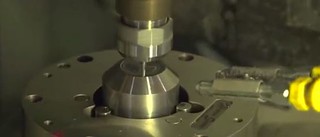
PREV ARTICLE
NEXT ARTICLE
FULL ISSUE
PREV FULL ISSUE
MINT ENGINEER'S IMPROVEMENT SAVES $MILLIONS
Les Rosenbaum forwarded this great story from Federal News Radio about a U.S. Mint employee's quest to solve a vexing coin production problem with help from the National Institute of Standards and Technology (NIST). Thanks! Be sure to watch the video. Crank it up if you're fan of Pink Floyd's "Money".
-Editor
Now, that solution saves the U.S. Mint roughly $2 million per year. "If you want to make a beautiful coin, first you have to make a beautiful blank," Ying said. A blank is a faceless coin. It becomes the coin we recognize after it is struck by a pair of die. An average die for a dime used to last about 100,000 to 150,000 strikes. That was a short life in Ying's mind. The dies seemed to wear out and crack, or break rather quickly. He wanted to know why. In 2006, Ying started looking at the lifespan of coin dies and began to generate a research database. Ying took his research to NIST. There, he met up with a former colleague, Dr. Richard Gates, who heads the Nanomechanical Properties Group at NIST. Ying worked at NIST when he was studying for his PhD, and he knew Gates, a nanotribologist, had the resources he needed. "Tribology is just the study of rubbing and, in more practical terms, it's the study of processes like friction, wear and lubrication," Gates said. "If you think of what nano might mean, the width of a human hair is about fifty microns and that's about 50,000 nanometers. So, nano is just really, really small. So nanotribology is the study of friction, wear and lubrication on a very small scale, and it's basically what happens on the surface of a coin during minting. And it's one of the processes that we studied to try to understand what was going on." The Mint had the coins and the problem to solve, but NIST had the right equipment and the environment. "In some ways, it's like a three bears problem — Goldilocks and the Three Bears. If you have too little lubricant, you have problems; you get too much lubricant, you get problems. If you have just the right amount, then you can get successful lubrication. That's what we ended up developing, basically a monomolecular — a very thin controlled amount of lubricant — that was just enough to strike a coin and allow the die life to increase," Gates said. And increase it did. The tedious work paid off. Die life has more than doubled since they changed the lubrication process. The Mint is saving roughly $2 million per year in the cost of equipment, and time and labor spent replacing the dies. The Mint is still tracking die life in the database, so it knows right away when something goes amiss. Just last year, the Mint saw a drop in the die life at the Philadelphia Mint. Ying said they were able to pinpoint the problem immediately as a defective pump. Without the ongoing database, the problem could have easily gone undetected. To read the complete article, see: Saving money by making money: One engineer's quest saves millions at the US Mint (www.federalnewsradio.com/1318/3681374/Saving-money-by-making-money-Engineers-quest-saves-millions-at-US-Mint)
THE BOOK BAZARREWayne Homren, Editor The Numismatic Bibliomania Society is a non-profit organization promoting numismatic literature. See our web site at coinbooks.org. To submit items for publication in The E-Sylum, write to the Editor at this address: whomren@gmail.com To subscribe go to: https://my.binhost.com/lists/listinfo/esylum All Rights Reserved. NBS Home Page Contact the NBS webmaster 
|
